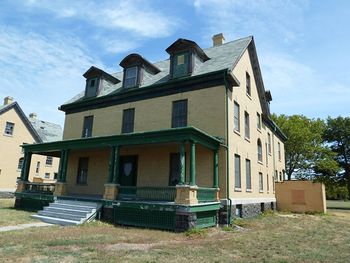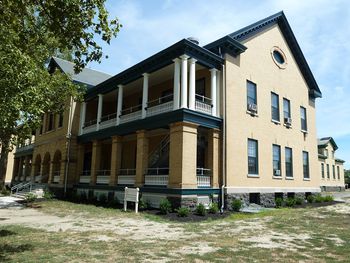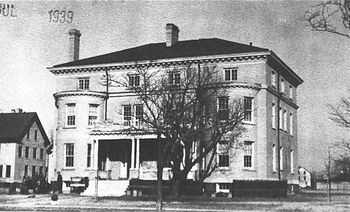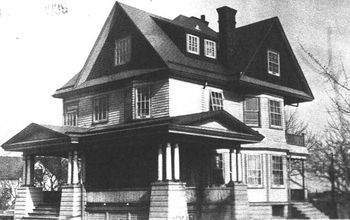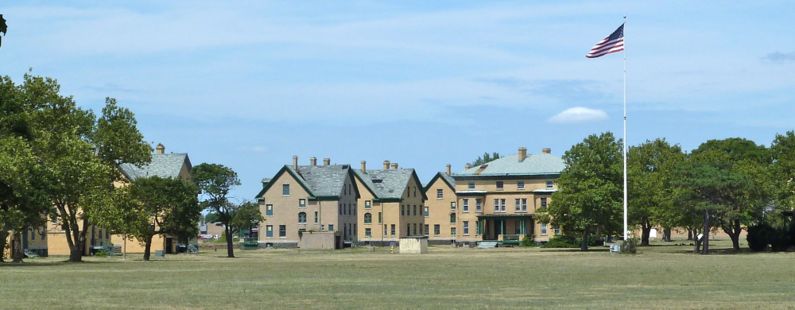Fort Hancock (2)
|
Fort Hancock (2) (1857-1972) - Sandy Hook peninsula was purchased by the Federal Government in several distinct parcels between 1806 and 1846. Construction started in 1857 for a large granite fort of the Third System Fort at Sandy Hook, located at Sandy Hook, Monmouth County, New Jersey. Renamed Fort Hancock in G.O. 57, 30 Oct 1895, after General Winfield Scott Hancock (Cullum 1223). Fort Hancock closed 31 Dec 1974 and transferred to the Department of the Interior, National Park Service. In 1982 the entire Sandy Hook peninsula was declared the "Fort Hancock Sandy Hook Proving Ground National Historic Landmark". Also known as Sandy Hook Fort. Third System (1816-1867)Part of the Harbor Defense of Southern New York. Established to provide protection to U.S. shipping and to guard an important shipping channel into New York Harbor. The original Third System Fort at Sandy Hook (1857-1885) was never completed. A new Endicott Period fort was established in 1892 and named Fort Hancock in 1895. Endicott Period (1890-1910)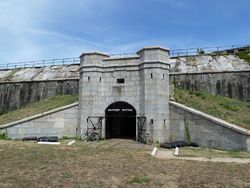 The Endicott Period began at Fort Hancock with the construction of two prototype batteries beginning in 1890. Battery Reynolds was a 12" sixteen mortar battery originally known as Sandy Hook Mortar Battery built between 1891-1894. Battery Potter was the first 12" disappearing gun battery built in the U.S., originally known as Gun Lift Battery 1 built between 1890-1894. Both of these batteries featured some sort of landside defense features which were not adopted in later batteries. The next round of batteries built at Fort Hancock built upon the lessons learned from the initial batteries and reflected a shift of disappearing gun technology from the steam-powered gun lift to the newer Buffington-Croizer counterweight carriages. Battery Halleck was begun in 1896 as a seven-gun battery built on top of the east wall of the old U.S. Civil War fort. It was later expanded to a nine-gun battery serving as a prototype of the main gun line concept and in 1904 was administratively divided into four batteries (Battery Halleck, Battery Alexander (2), Battery Bloomfield and Battery Richardson). Battery Granger was built between 1896-1898 as the second 10" gun battery with the newer Buffington-Croizer counterweight carriages. After the completion of the main gun line, the remaining batteries built were separate batteries, 6" caliber and under.
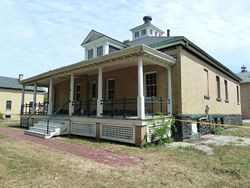 The initial plan for post buildings to support the garrison was developed by Capt. Arthur Murray in 1896 and by 1899 the first phase of post construction was complete. The post included four 80 man barracks, 38 officers quarters, a 50-bed hospital, a bakery, bachelor officers quarters, guardhouse and support buildings. The post was aligned around a parade ground with the 38 officers quarters along the west side of the parade ground, all facing the bay. The four barracks buildings were aligned along the east side of the parade ground also facing the bay. At the north end of the parade ground were the bachelor officers quarters (BOQ) and the administration building The post was first garrisoned in early 1898 as the Spanish-American War began. The permanent buildings on the post were not yet complete and many of the units were housed in tents. The garrison began to occupy the new quarters at the end of 1898 and the beginning of 1899. Initially designed as a four company post, it was expanded in 1907 to six companies and a new 218 man double barracks was constructed to house the enlarged garrison. The capacity of the four original barracks was also expanded to 109 men by constructing a separate building for the mess hall and converting that space to quarters.
World War I (1917-1918)In early 1917 construction was started on two new 12" gun batteries on the bay side of Sandy Hook at Horseshoe Cove. Battery Mills and Battery Kingman were almost identical, open plan, 12" batteries with each having two open gun emplacements separated by a large earth covered concrete magazine. The open nature of the gun emplacements allowed a theoretical 360-degree field of fire with an ARF carriage and an elevation between zero and 35 degrees. This configuration gave the guns a higher arc trajectory and longer range than the same guns mounted in disappearing carriages. The drawback of the open plan was that the gun and crew are totally exposed to hostile fire and aircraft. These two batteries were not completed until well after the end of the war in 1921. The six-company capacity of Fort Hancock was quickly exceeded in the run-up to World War I and by the end of 1917 seven additional cantonments were completed to providing housing for 1,792 enlisted men and 42 officers. The quarters and support buildings included twenty-seven, 66 man barracks and 28 sets of officer quarter all of temporary batten and tar paper construction. Even before these temporary cantonments were complete an additional regiment was posted to Fort Hancock for training prior to shipment overseas and the post quickly exceeded its capacity and additional structures were built. The crowding at Fort Hancock continued even after the end of the war as the post processed returnees for discharge through March 1919. Demobilization was rapid and by June 1919 the post was reduced to caretaker status.
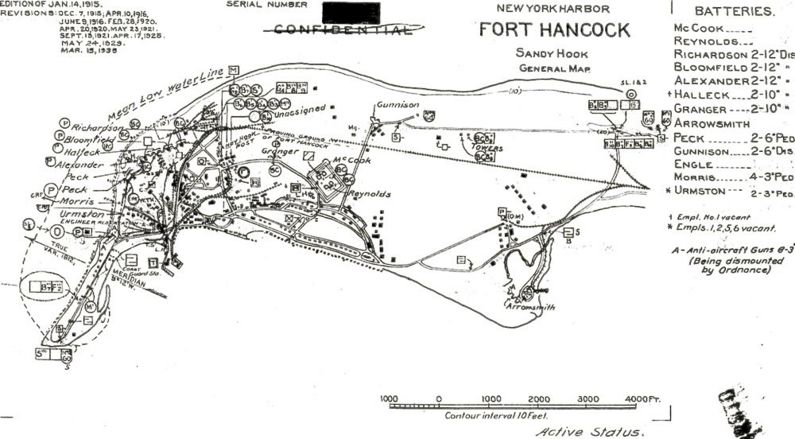
No permanent buildings were built during the 1920s which was a period of austerity for the military. The 1930s saw the creation of the WPA and several new buildings were added to the post including a post theater. World War II (1941-1945)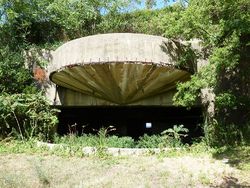 In 1940 the War Department issued a $ 100,000,000 upgrade plan for coastal defense that included a combination of new 16" and 6" shore batteries, 3" AMTB and anti-aircraft batteries, upgrades to existing rapid fire 3" batteries by shielding them and finally a casemate program for most of the open plan 12" batteries. Battery Mills and Battery Kingman were both selected to be casemated and construction began in 1942 and continued into 1943. The new 16" and 6" batteries were placed in the Highlands Military Reservation and designated Battery 116 - Battery Lewis (2) and Battery 219. Even before the new batteries came online, the old batteries were declared obsolete and scrapped. By 1944, the only Endicott batteries remaining active were Battery Gunnison (New Peck), Battery Urmston and Battery Morris. Battery Mills and Battery Kingman were casemated, two AMTB batteries had been installed and the batteries in the Highlands Military Reservation were completed. In 1940 the buildup toward World War II began at Fort Hancock with the federalization of the National Guard and the call-up of reserve units. Later that year the draft began and draftees began arriving at Fort Hancock. the World War I temporary structures were long gone and a new set of temporary buildings was rushed to completion. A tent cantonment of 384 winterized tent platforms along with mess halls, latrines and service buildings was constructed for arriving Coast Artillery units. During the war, the post population varied from 7,000 to over 18,000. In 1943, an Advanced Harbor Entrance Control Post (HECP) #1 was established on Battery Potter in conjunction with the Navy Signal Station to supplement the main HECP at Fort Wadsworth and control shipping in the Sandy Hook area. Advanced HECP #2 was established on Fort Tilden with the same aims. The Harbor Defense Command Post (HDCP) for the Harbor Defense of New York was in place in Battery McCook and Battery Gunnison became the Examination Battery for ships entering the harbor. As the war wound down in 1945 the mines were picked up from the harbor, armaments were reduced from category A to category C and the HECPs were closed on 18 Jun 1945. By the end of 1945, the harbor defenses had returned to peacetime status and personnel levels had dropped to 46 officers, 9 warrant officers, and 769 enlisted troops. During the demobilization after the war, the population grew to over 18,000 as personnel returned home from overseas for discharge.
Cold War (1947-1991)Fort Hancock was deactivated on 27 Jun 1950 just two days after the Korean War started and by 10 Apr 1951, it was reactivated. The reactivation did not last long and it was again deactivated on 1 May 1953 and reactivated 1 Jul 1956. The reactivation came as the U.S. Army deployed a NIKE-AJAX missile system to the post. On 1 Sep 1959, the NIKE-HERCULES missile system was deployed to Fort Hancock. The NIKE-HERCULES system on Fort Hancock was formally deactivated on 15 Aug 1974. The post closed 31 Dec 1974.
Current StatusThe historic fort is now managed as the Sandy Hook Unit of Gateway National Recreation Area, National Park Service. The totality of the Sandy Hook peninsula to include both the National Park Service and US Coast Guard Station is the Fort Hancock Sandy Hook Proving Ground National Historic Landmark District. Battery Gunnison has two display guns and carriages, both of which have functional breech blocks and elevation. Gun #1 traverses. The plotting room for the examination battery years has been recreated with much of the communications equipment operational. Battery Potter, although empty, is a great tour and well worth the time. Check with the park for times when these batteries are open for tours.
Recent Blog Posts: Sources:
Links: Visited: 12 Aug 2010 | |||||||||||||||||||||||||||||||||||||||||||||||||||||||||||||||||||||||||||||||||||||||||||||||||||||||||||||||||||||||||||||||||||||||||||||||||||||||||||||||||||||||||||||||||||||||||||||||||||||||||||||||||||||||||||||||||||||||||||||||||||||||||||||||||||||||||||||||||||||||||||||||||||||||||||||||||||||||||||||||||||||||
